An Integrated Approach to Unravelling Smallholder Yield Levels: The Case of Small Family Farms, Eastern Region, Ghana
Abstract
1. Introduction
1.1. Factors Influencing Yield Levels
1.2. Role of Socioeconomic Factors
2. Materials and Methods
2.1. Study Villages
2.2. Plot Selection and Household Sampling
2.3. Yield Measurement
2.4. Statistical Analysis
2.5. Principal Components
2.6. Aerial Photography
2.7. Photo-Elicitation Interviews
3. Results
3.1. Household Characteristics and Farming Systems Practices
3.2. Description of Variables
3.3. Factors Affecting Maize Yields
3.4. Spatial Variability in Maize Yields
“Competition from nearby bushes and forest that were not cleared for the current season contributes to the poor patches. This cannot be remedied unless I am lucky and my neighbour also cultivates his field. Partridges also prefer to pick off seeds near the borders of fields and this often leads to sparse maize density on these areas”—Mr. JT, male, 57, Akatawia.
“You could see the poorer patches are generally closer to the borders where my neighbour did not clear his plot. So, I think the lack of breathing space for crops in these areas as well as draining of nutrients by nearby bushes contributed to the poor patches. It is always this way unless you are lucky and your neighbours also cultivate their fields or you are able to clear shades of trees from nearby fields. This can be difficult if your neighbours are also trying to fallow their lands. But if you are lucky and all your neighbours cultivate their fields, you would have a more even crop performance”—Mr. KYT, male, 62, Asitey.
“I see the borders having poor patches, but it is because the neighbouring farmers did not cultivate their own fields. As a result, the shades from other fields affect my own field. So even though there are advantages to farming further away and deeper into the forest, in terms of weed infestation, there are disadvantages too with regards to shades from neighbouring uncultivated lands which affect the vigour of crops on the borders”—Mr. TAT, male, 77, Akatawia.
“The higher parts have poorer crops because there is inadequate water [moisture] in the soil. The crops in the low lying parts look better not only because there is [relatively] more water [moisture] in the soil but also because the top rich soil, including any fertiliser applied, could be washed off the higher terrain and deposited in the lower-lying parts”—Mr. PNK, male, 58, Asitey.
4. Discussions
4.1. Importance of Maize Planting Time
“I stagger the planting over the week; twice in the course of the week… I only spread the planting over two days because of the limitations with labour availability. If I had a lot more people, I would plant the whole field in a day”—Mr. PNK, male, 58, Asitey
“We don’t [intentionally] stagger planting, if one has the strength [labour power] … If you cultivate several acres, then you are going [have to] do it in multiple locations because you cannot get a large field in the same place. This means that you can plant a particular field today and then the other [field] the next day. But if you want all fields at the right time, then you have to rely on hired labour, which can be very expensive”—Mr. AAA, male, 33, Akatawia.
4.2. Underlying Role of Socioeconomic Factors
“These photos will be very useful to us because now we can clearly see [from the sky] which portions [of the maize field] are good and then we can neglect the portions that are not productive in the coming season. As you know, we don’t pay for the land, it was released to us by the Forestry people so we will just concentrate on the productive parts and ignore the unproductive areas. The problem is that sometimes we are forced to continue clearing the whole plot because that is one of the conditions for having been given access to the land. If not, another farmer could start encroaching. So even if it is not yielding much maize, one could try other crops otherwise you lose your rights to the plot”—Mr. JA, male, 77, Asitey.
4.3. Importance of Multi-Methods and Data in Explaining Yield Levels
5. Conclusions
Author Contributions
Funding
Acknowledgments
Conflicts of Interest
References
- De Graaff, J.; Kessler, A.; Nibbering, J.W. Agriculture and food security in selected countries in Sub-Saharan Africa: Diversity in trends and opportunities. Food Secur. 2011, 3, 195–213. [Google Scholar] [CrossRef]
- Dzanku, F.M.; Jirström, M.; Marstorp, H. Yield gap-based poverty gaps in rural Sub-Saharan Africa. World Dev. 2015, 67, 336–362. [Google Scholar] [CrossRef]
- Canning, D.; Sangeeta, R.; Abdo, S.Y. Africa’s demographic transition: Dividend or disaster? In Africa Development Forum Series; World Bank: Washington, DC, USA, 2015. [Google Scholar]
- PRB. 2017 World population Data Sheet: With Special Focus On Youth; Population Reference Bureau: Washington, DC, USA, 2017. [Google Scholar]
- Abate, T.; Fisher, M.; Abdoulaye, T.; Kassie, G.T.; Lunduka, R.; Marenya, P.; Asnake, W. Characteristics of maize cultivars in Africa: How modern are they and how many do smallholder farmers grow? Agric. Food Secur. 2017, 6, 30. [Google Scholar] [CrossRef]
- Onyutha, C. African crop production trends are insufficient to guarantee food security in the sub-Saharan region by 2050 owing to persistent poverty. Food Secur. 2018, 10, 1203–1219. [Google Scholar] [CrossRef]
- Lobell, D.B. The use of satellite data for crop yield gap analysis. Field Crop. Res. 2013, 143, 56–64. [Google Scholar] [CrossRef]
- Jirström, M.; Archila-Bustos, M.F.; Loison, A. African smallholder farmers on the move: Farm. and non-farm trends for six sub-saharan african countries, 2002–2015. In Agriculture, Diversification, and Gender In Rural Africa: Longitudinal Perspectives From Six African Countries; Andersson-Djurfeldt, A., Dzanku, F.M., Isinika, A.C., Eds.; Oxford University Press: Oxford, UK, 2018; pp. 17–53. [Google Scholar]
- Ray, D.K.; Gerber, J.S.; MacDonald, G.K.; West, P.C. Climate variation explains a third of global crop yield variability. Nat. Commun. 2015, 6, 1–19. [Google Scholar] [CrossRef]
- Falconnier, G.N.; Descheemaeker, K.; Mourik, T.A.V.; Giller, K.E. Unravelling the causes of variability in crop yields and treatment responses for better tailoring of options for sustainable intensification in southern Mali. Field Crop. Res. 2016, 187, 113–126. [Google Scholar] [CrossRef]
- Rurangwa, E.; Vanlauwe, B.; Giller, K.E. Benefits of inoculation, P fertilizer and manure on yields of common bean and soybean also increase yield of subsequent maize. Agricult. Ecosys. Environ. 2018, 261, 219–229. [Google Scholar] [CrossRef]
- Gregory, P.J.; George, T.S. Feeding nine billion: The challenge to sustainable crop production. J. Exp. Botany 2011, 62, 5233–5239. [Google Scholar] [CrossRef]
- Górski, T.; Górska, K. The effects of scale on crop yield variability. Agric. Syst. 2003, 78, 425–434. [Google Scholar] [CrossRef]
- Hoffmann, M.P.; Haaakana, M.; Asseng, S.; Höhn, J.G.; Palosuo, T.; Ruiz-Ramos, M.; Fronzek, S.; Ewert, F.; Gaiser, T.; Kassie, B.T.; et al. How does inter-annual variability of attainable yield affect the magnitude of yield gaps for wheat and maize? An. analysis at ten sites. Agric. Syst. 2018, 159, 199–208. [Google Scholar]
- Van Loon, M.P.; Adjei-Nsiah, S.; Descheemaeker, K.; Akotsen-Mensah, C.; van Dijk, M.; Morley, T.; van Ittersum, M.K.; Reidsma, P. Can. yield variability be explained? Integrated assessment of maize yield gaps across smallholders in Ghana. Field Crops Res. 2019, 236, 132–144. [Google Scholar] [CrossRef]
- Chi, B.-L.; Bing, C.-S.; Walley, F.; & Yates, T. Topographic indices and yield variability in a rolling landscape of western Canada. Pedosphere 2009, 19, 362–370. [Google Scholar] [CrossRef]
- Bölenius, E.; Stenberg, B.; Arvidsson, J. Within field cereal yield variability as affected by soil physical properties and weather variations—A case study in east central Sweden. Geoderma Reg. 2017, 11, 96–103. [Google Scholar] [CrossRef]
- Kraaijvanger, R.; Veldkamp, A. The importance of local factors and management in determining wheat yield variability in on-farm experimentation in Tigray, northern Ethiopia. Agric. Ecosyst. Environ. 2015, 214, 1–9. [Google Scholar] [CrossRef]
- Burke, M.; Lobell, D.B. Satellite-based assessment of yield variation and its determinants in smallholder African systems. Proc. Natl. Acad. Sci. USA 2017, 114, 2189–2194. [Google Scholar] [CrossRef]
- Farmaha, B.S.; Lobell, D.B.; Boone, K.E.; Cassman, K.G.; Yang, H.S.; Grassini, P. Contribution of persistent factors to yield gaps in high-yield irrigated maize. Field Crops Res. 2016, 186, 124–132. [Google Scholar] [CrossRef]
- Mourice, S.K.; Tumbo, S.D.; Nyambilila, A.; Rweyemamu, C.L. Modeling rain-fed maize productivity and yield gaps in the Wami River sub-basin, Tanzania. Acta Agric. Scand. Sect. B Soil Plant Sci. 2015, 65, 132–140. [Google Scholar] [CrossRef]
- Silva, J.V.; Reidsma, P.; Laborte, G.A.; Van Ittersum, K.M. Explaining rice yields and yield gaps in central Luzon, Philippines: Application of stochastic frontier analysis and crop modeling. Eur. J. Agron. 2017, 82, 223–241. [Google Scholar] [CrossRef]
- Assefa, B.T.; Chamberlin, J.; Reidsma, P.; Silva, J.V.; van Ittersum, M.K. Unravelling the variability and causes of smallholder maize yield gaps in Ethiopia. Food Secur. 2019, 12, 83–103. [Google Scholar] [CrossRef]
- Adu, G.; Abdulai, M.S.; Alidu, H.; Nustugah, S.; Buah, S.; Kombiok, J.; Obeng-Antwi, K.; Abudulai, M.; Etwire, P. Recommended Production Practices for Maize in Ghana. 2014. Available online: https://www.researchgate.net/profile/Gloria_Adu/publication/270511013_Recommended_Production_Practices_for_Maize_in_Ghana/links/54ac72dc0cf23c69a2b7d532.pdf (accessed on 21 February 2020).
- Dobor, L.; Barcza, Z.; Hlásny, T.; Árendás, T.; Spitkó, T.; Fodor, N. Crop. planting date matters: Estimation methods and effect on future yields. Agric. Forest Meteorol. 2016, 223, 103–115. [Google Scholar] [CrossRef]
- Niang, A.; Becker, M.; Ewert, F.; Dieng, I.; Gaiser, T.; Tanaka, A.; Senthilkumar, K.; Rodenburg, J.; Johnson, J.-M.; Akakpo, C.; et al. Variability and determinants of yields in rice production systems of West Africa. Field Crops Res. 2017, 207, 1–12. [Google Scholar] [CrossRef]
- Yengoh, G.T. Determinants of yield differences in small-scale food crop farming systems in Cameroon. Agric. Food Secur. 2012, 1, 19. [Google Scholar] [CrossRef]
- Day, R.; Abrahams, P.; Bateman, M.; Beale, T.; Clottey, V.; Cock, M.; Colmenarez, Y.; Corniani, N.; Early, R.; Godwin, J.; et al. Fall Armyworm: Impacts and Implications for Africa. Outlooks Pest Manag. 2017, 28, 196–201. [Google Scholar] [CrossRef]
- Gianessi, L.P. The increasing importance of herbicides in worldwide crop production. Pest Manag. Sci. 2013, 69, 1099–1105. [Google Scholar] [CrossRef]
- Krenchinski, F.H.; Albrecht, A.J.P.; Salomão Cesco, V.J.; Rodrigues, D.M.; Pereira, V.G.C.; Albrecht, L.P.; Carbonari, C.A.; Victória Filho, R. Post-emergent applications of isolated and combined herbicides on corn culture with cp4-epsps and pat genes. Crop Protect. 2018, 106, 156–162. [Google Scholar] [CrossRef]
- Snyder, A.K.; Miththapala, S.; Sommer, R.; Braslow, J. The yield gap: Closing the gap by widening the approach. Exp. Agric. 2016, 53, 1–15. [Google Scholar] [CrossRef]
- Mueller, D.N.; Binder, S. Closing yield gaps: Consequences for the global food supply, environmental quality & food security. Daedalus 2015, 144, 45–56. [Google Scholar]
- Affholder, F.; Poeydebat, C.; Corbeels, M.; Scopel, E.; Tittonell, P. The yield gap of major food crops in family agriculture in the tropics: Assessment and analysis through field surveys and modelling. Field Crops Res. 2013, 143, 106–118. [Google Scholar] [CrossRef]
- Scoones, I. Sustainable Rural Livelihoods: A framework for Analysis; IDS Working Paper 72; Institute of Development Studies: Brighton, UK, 1998. [Google Scholar]
- Allison, E.H.; Ellis, F. The livelihoods approach and management of small-scale fisheries. Marine Policy 2001, 25, 377–388. [Google Scholar] [CrossRef]
- Bebbington, A. Capitals and Capabilities: A Framework for Analyzing Peasant Viability, Rural Livelihoods and Poverty. World Develop. 1999, 27, 2021–2044. [Google Scholar] [CrossRef]
- DfID. Sustainable livelihoods Guidance Sheet; Livelihoods, Ed.; Department for International Development: London, UK, 1999. [Google Scholar]
- Beddow, J.M.; Hurley, T.M.; Pardey, P.G.; Alston, J.M. Food security: Yield gap. In Encyclopedia of Agriculture and Food Systems; Alfen, N.V., Ed.; Elsevier: San Diego, CA, USA, 2015; pp. 352–365. [Google Scholar]
- Beza, E.; Silva, J.V.; Kooistra, L.; Reidsma, P. Reviewing yield gap explaining factors and opportunities for alternative data collection approaches. Eur. J. Agron. 2017, 82, 206–222. [Google Scholar] [CrossRef]
- Jirström, M. In the Wake of the Green Revolution: Environmental and Socioeconomic Consequences of Intensive Rice Agriculture-The Problems of Weeds in Muda, Malaysia; Lund University Publications: Lund, Sweden, 1996; p. 273. [Google Scholar]
- Norman, W.D. The farming systems approach: A historical perspective. In Proceedings of the 17th Symposium of the International Farming Systems Association, Lake Buena Vista, FL, USA, 17–20 November 2002. [Google Scholar]
- Frelat, R.; Lopez-Rudaura, S.; Giller, K.E.; Herrero, M.; Douxchamps, S.; Andersson-Djurfeldt, A.; Erenstein, O.; Henderson, B.; Kassie, M.; Paul, B.K.; et al. Drivers of household food availability in Sub-Saharan Africa based on big data from small farms. Proc. Natl. Acad. Sci. USA 2016, 113, 458–463. [Google Scholar] [CrossRef] [PubMed]
- Henderson, B.; Godde, C.; Medina-Hidalgo, D.; Van Wijk, M.T.; Silvestri, S.; Douxchamps, S.; Stephenson, E.; Power, B.; Rigolot, C.; Cocha, O.; et al. Closing system-wide yield gaps to increase food production and mitigate GHGs among mixed crop-livestock smallholders in Sub-Saharan Africa. Agric. Syst. 2016, 143, 106–113. [Google Scholar] [CrossRef]
- Dijk, M.V.; Meijerink, G.W.; Rau, M.L.; Shutes, K. Mapping Maize Yield Gaps in Africa; Can A Leopard Change Its Spots? LEI: Hague, The Netherlands, 2012. [Google Scholar]
- Neumann, K.; Verburg, P.H.; Stehfest, E.; Müller, C. The yield gap of global grain production: A spatial analysis. Agric. Syst. 2010, 103, 316–326. [Google Scholar] [CrossRef]
- Ray, D.K.; Ramankutty, N.; Mueller, N.D.; West, P.C.; Foley, J.A. Recent patterns of crop yield growth and stagnation. Nat. Commun. 2012, 3, 1293. [Google Scholar] [CrossRef]
- Hayami, Y.; Ruttan, V.W. Agricultural Development: An. International Perspective; John Hopkins University Press: Baltimore, MD, USA, 1985. [Google Scholar]
- Kikuchi, M.; Hayami, Y. Inducements to Institutional Innovations in an Agrarian Community. Econ. Develop. Cult. Change 1980, 29, 21–36. [Google Scholar] [CrossRef]
- GSS. 2010 Population and Housing Census: District Analytical Report. Upper Manya Krobo District; Ghana Statistical Service: Accra, Gana, 2014. [Google Scholar]
- GSS. 2010 population and Housing Census: District Analytical Report. Lower Manya Krobo Municipality; Ghana Statistical Service: Accra, Gana, 2014. [Google Scholar]
- Djurfeldt, G.; Aryeetey, E.; Isinika, A.C.E. African Smallholders: Food Crops, Markets and Policy; Djurfeldt, G., Aryeetey, E., Isinika, A.C., Eds.; CAB International: Wallingford, UK, 2011; p. 397. [Google Scholar]
- Djurfeldt, G.; Holmen, H.; Jirström, M.; Larson, R. The African food crisis: Lessons from the Asian Green Revolution; CAB International: Wallingford, UK, 2005; pp. 1–9. [Google Scholar]
- Wahab, I.; Hall, O.; Jirström, M. Remote sensing of yields: Application of UAV imagery-derived NDVI for estimating maize vigor and yields in complex. Farming systems in sub-Saharan Africa. Drones 2018, 2, 28. [Google Scholar] [CrossRef]
- Wahab, I. In-season plot area loss and implications for yield estimation in smallholder rainfed farming systems at the village level. GeoJournal 2019. [Google Scholar] [CrossRef]
- Yeboah, E.; Kahl, H.; Arndt, C. Soil Testing Guide; CSIR-Ghana: Accra, Gana, 2013. [Google Scholar]
- FAO. Methodology for Estimation of Crop Area and Crop Yield Under Mixed and Continuous Cropping; FAO: Rome, Italy, 2017. [Google Scholar]
- Shapiro, S.S.; Wilk, M.B. An analysis of variance test for normality (complete samples). Biometrika 1965, 52, 591–611. [Google Scholar] [CrossRef]
- Bryman, A.; Cramer, D. Quantitative Data Analysis with SPSS 12 and 13: A guide for Social Scientists; Routledge: London, UK, 2005. [Google Scholar]
- Kaiser, H.F. An index of factorial simplicity. Psychometrika 1974, 39, 31–36. [Google Scholar] [CrossRef]
- Grisso, R.; Alley, M.; Phillips, S.; McClellan, P. Interpreting Yield Maps: ‘I Gotta Yield Map, Now What?’; Virginia Cooperative Extension Publications: Blacksburg, VA, USA, 2009; Volume 442, pp. 442–509. [Google Scholar]
- MoFA-SRID. Agriculture in Ghana: Facts and Figures 2016; Statistics, Research, and Information Directorate of the Ministry of Food and Agriculture: Accra, Ghana, 2017. [Google Scholar]
- Tittonell, P.; Giller, K.E. When yield gaps are poverty traps: The paradigm of ecological intensification in African smallholder agriculture. Field Crops Res. 2013, 143, 76–90. [Google Scholar] [CrossRef]
- Ajayi, O.C.; Place, F.; Akinnifesi, F.K.; Sileshi, G.W. Agricultural success from Africa: The case of fertilizer tree systems in southern Africa (Malawi, Tanzania, Mozambique, Zambia and Zimbabwe). Int. J. Agric. Sus. 2011, 9, 129–136. [Google Scholar] [CrossRef]
- Morris, M.; Kelly, V.A.; Kopicki, R.J.; Byerlee, D. Fertilizer Use in African Agriculture: Lessons Learned and Good Practice Guidelines; The World Bank: Washington, DC, USA, 2007. [Google Scholar]
- Marteau, R.; Sultan, B.; Moron, V.; Alhassane, A.; Baron, C.; Traoré, S.B. The onset of the rainy season and farmers’ sowing strategy for pearl millet cultivation in Southwest Niger. Agric. Forest Meteorol. 2011, 151, 1356–1369. [Google Scholar] [CrossRef]
- Waha, K.; Müller, C.; Bondeau, A.; Dietrich, J.P.; Kurukulasuriya, P.; Heinke, J.; Lotze-Campen, H. Adaptation to climate change through the choice of cropping system and sowing date in sub-Saharan Africa. Global Environ. Change 2013, 23, 130–143. [Google Scholar] [CrossRef]
- Srivastava, A.K.; Mboh, C.M.; Gaiser, T.; Webber, H.; Ewert, F. Effect of sowing date distributions on simulation of maize yields at regional scale—A case study in Central Ghana, West. Africa. Agric. Syst. 2016, 147, 10–23. [Google Scholar] [CrossRef]
- Ndoli, A. Farming with trees: A balancing act in the shade. In C.T. De Wit Graduate School of Production Ecology and Resource Conservation; Wageningen University: Wageningen, The Netherlands, 2018. [Google Scholar]
- Chambers, R.; Conway, R.G. Sustainable Rural Livelihoods: Practical Concepts for the 21st Century; IDS Discussion Paper 296; Institute of Development Studies: Brighton, UK, 1991. [Google Scholar]
- Binswanger-Mkhize, H.P.; Savastano, S. Agricultural intensification: The status in six African countries. Food Policy 2017, 67, 26–40. [Google Scholar] [CrossRef]
- Lambrecht, B.I. As a husband, I will love, lead and provide. Gendered access to land in Ghana. World Dev. 2016, 88, 188–200. [Google Scholar] [CrossRef]
- Sida, T.S.; Baudron, F.; Hadgu, K.; Derero, A.; Giller, K.E. Crop. vs. tree: Can. agronomic management reduce trade-offs in tree-crop interactions? Agric. Ecosyst. Environ. 2018, 260, 36–46. [Google Scholar] [CrossRef]
- Tiwari, T.P.; Brook, R.M.; Wagstaff, P.; Sinclair, F.L. Effects of light environment on maize in hillside agroforestry systems of Nepal. Food Secur. 2012, 4, 103–114. [Google Scholar] [CrossRef]
- Codjoe, S.N.A. Population growth and agricultural land use in two agro-ecological zones of Ghana, 1960–2010. Int. J. Environ. Stud. 2006, 63, 645–661. [Google Scholar]
- Benneh, G.; Kasanga, K.; Amoyaw, D. Land tenure and women’s access to agricultural land: A case study of three selected districts in Ghana. Land 1997, 1, 104. [Google Scholar]
- Ruthenberg, H. Farming Systems in the Tropics; Clarendon Press: Oxford, UK, 1971. [Google Scholar]
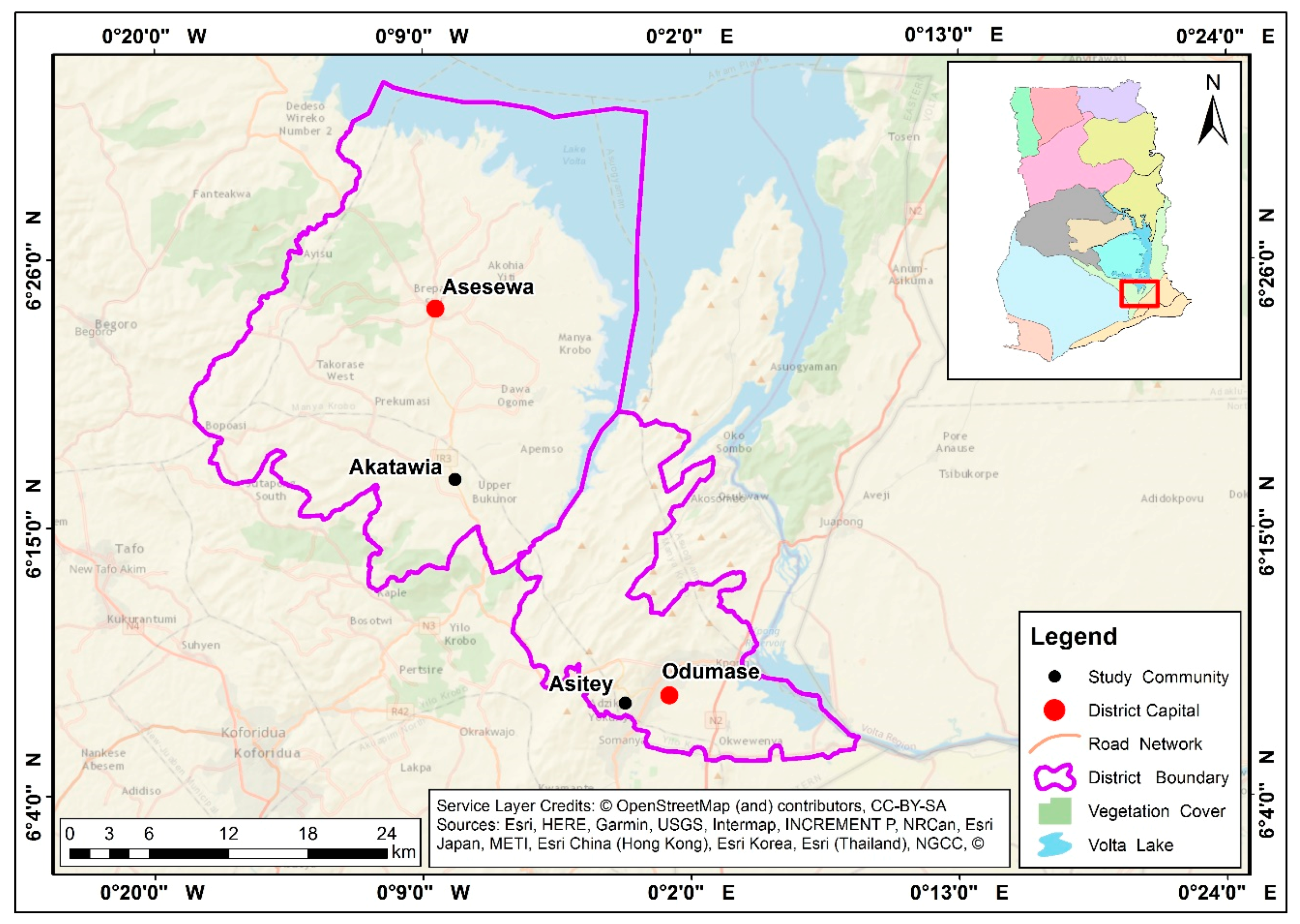
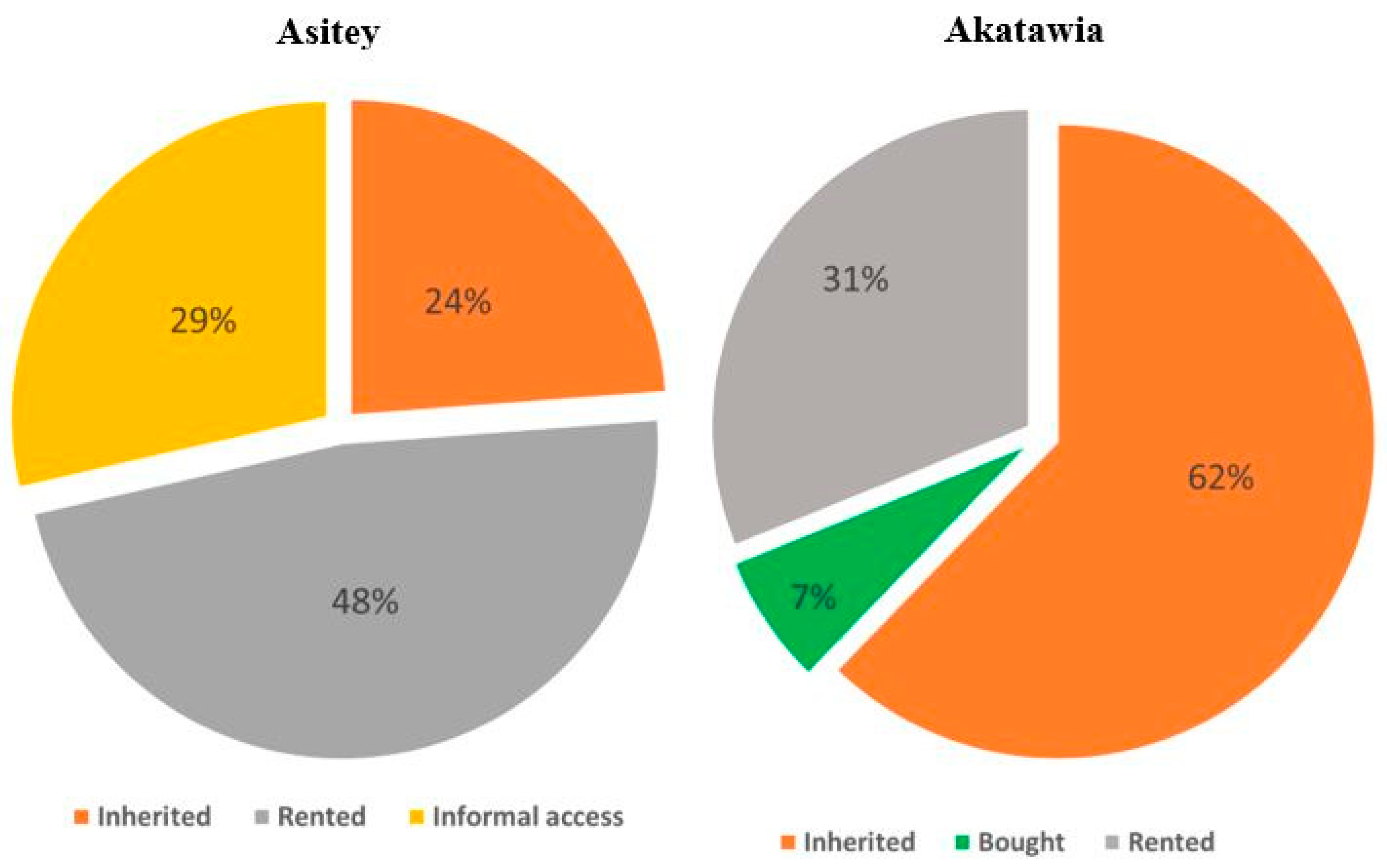
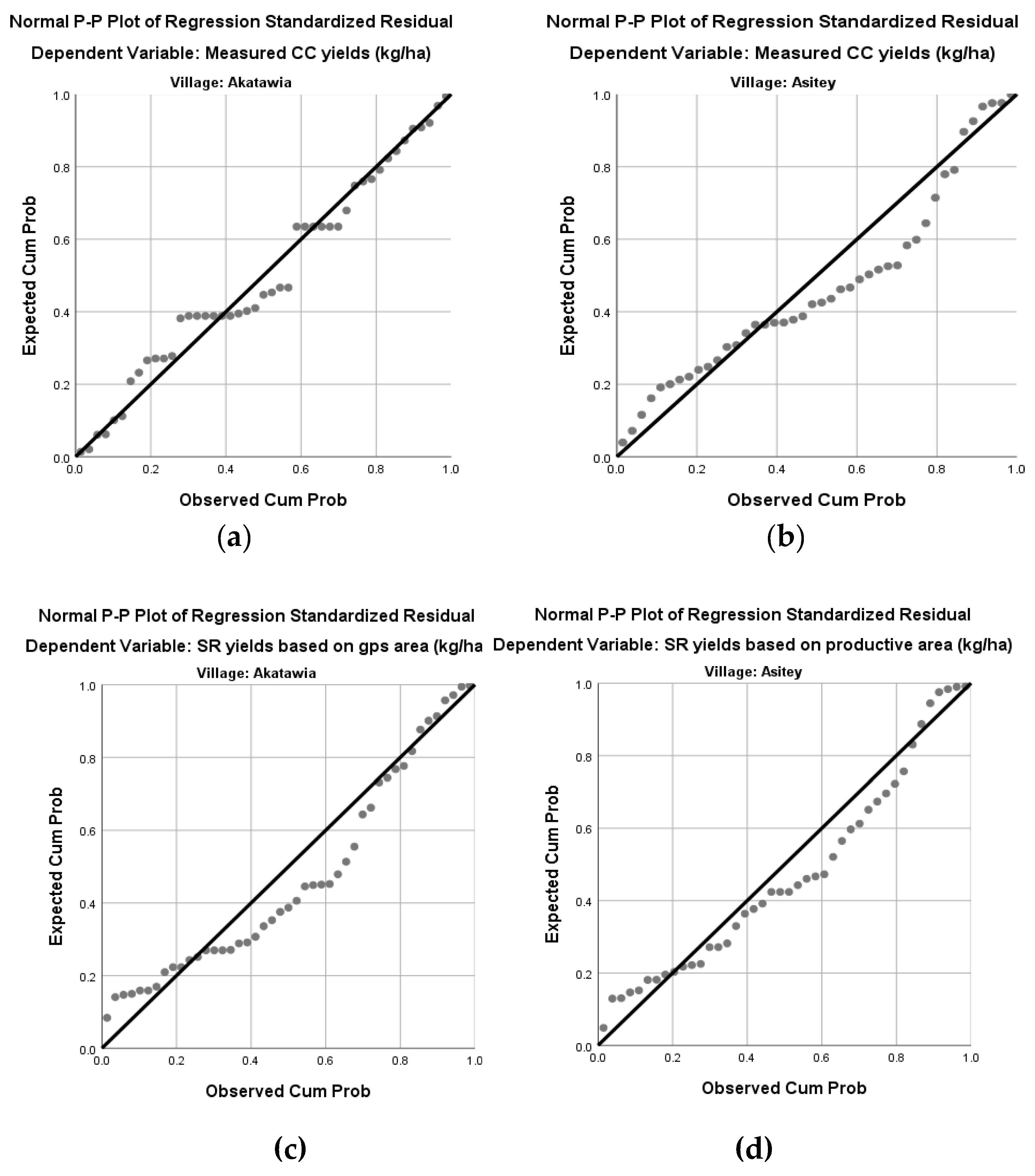
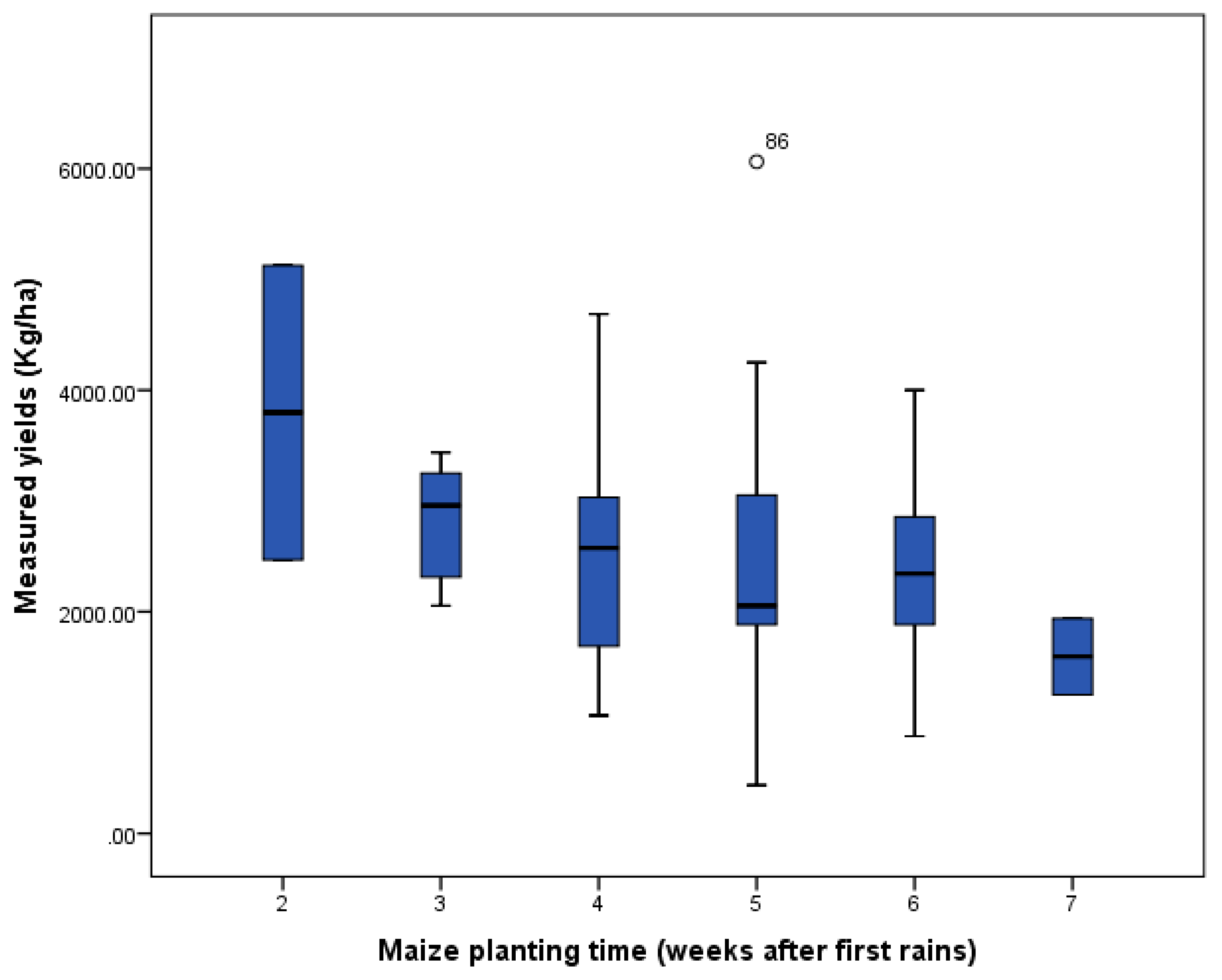
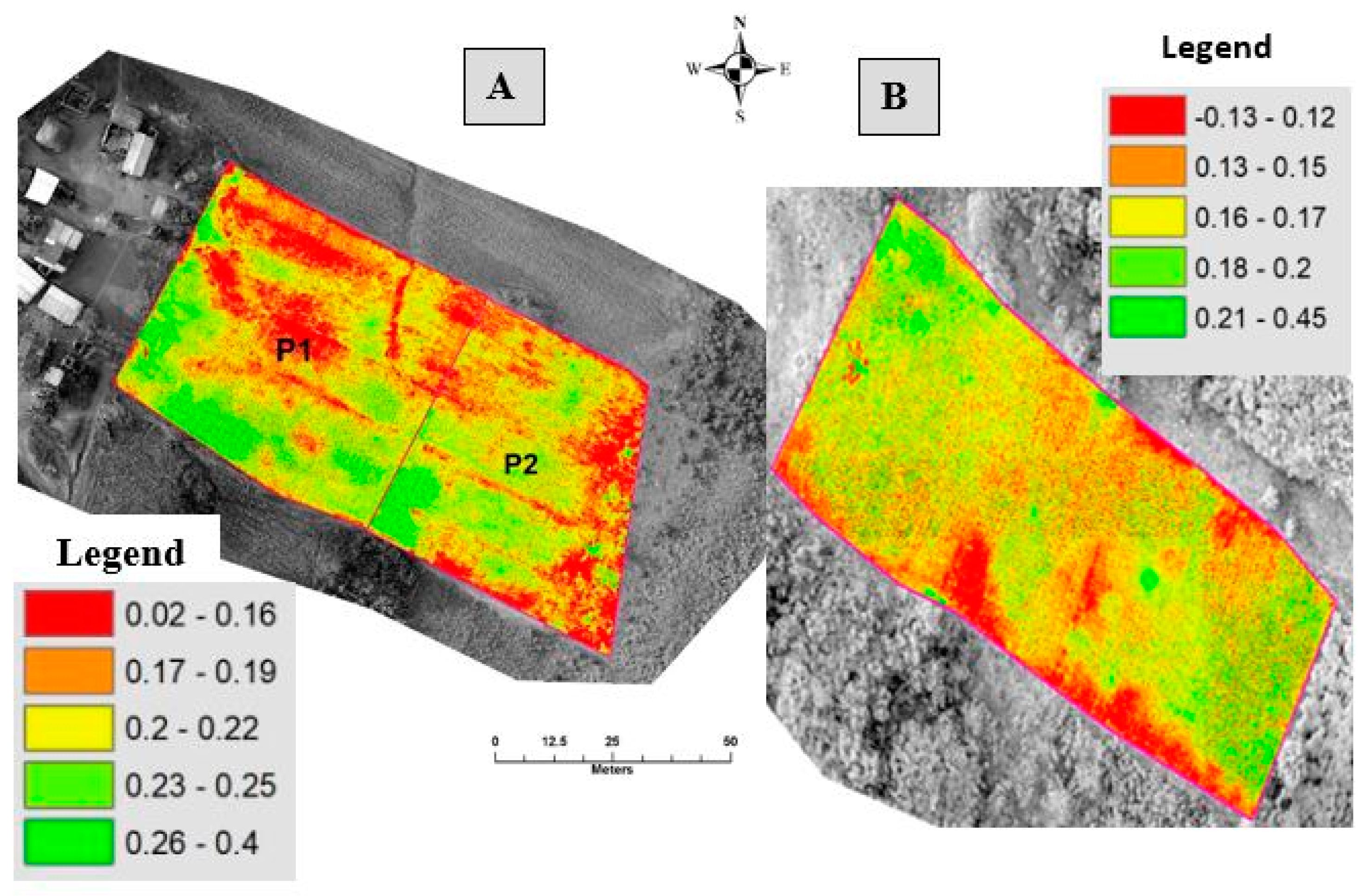
| Variable | Lower Manya Krobo (Site: Asitey) | Upper Manya Krobo (Site: Akatawia) |
|---|---|---|
| Altitude (metres above sea level) | 150–600 | 120–440 |
| Annual rainfall range (mm) | 900–1150 | 900–1500 |
| Mean temperature range (°C) | 26–35 | 26–32 |
| Relative humidity (g/m3) | 70–95 | 75–95 |
| Population density (pers. Per sq. km) | 293 | 84 |
| Proportion of rural population (%) | 16 | 84 |
| Proportion of pop engaged in agric | 66 | 73 |
| Major market centres | Somanya, Odumase, and Kpong | Akatim, Sekesua and Asesewa |
| Communalities | 1 | 2 | 3 | 4 | |
|---|---|---|---|---|---|
| Cation exchange capacity | 0.843 | 0.896 | 0.135 | 0.020 | 0.147 |
| Nitrogen percentage | 0.781 | 0.881 | 0.037 | 0.046 | 0.032 |
| Magnesium | 0.810 | 0.880 | 0.166 | 0.090 | 0.000 |
| Percentage of clay | 0.660 | 0.714 | −0.043 | 0.360 | 0.140 |
| Potassium | 0.642 | 0.537 | 0.267 | 0.140 | 0.512 |
| pH | 0.805 | 0.118 | 0.857 | 0.238 | 0.024 |
| Percentage of sand | 0.729 | −0.121 | 0.789 | −0.303 | 0.016 |
| Sodium | 0.496 | 0.218 | 0.668 | 0.032 | 0.020 |
| Percentage of silt | 0.927 | 0.065 | 0.071 | 0.958 | −0.034 |
| Soil electrical conductivity | 0.503 | 0.452 | −0.081 | 0.537 | −0.051 |
| Average soil penetrability | 0.668 | 0.011 | −0.270 | 0.053 | 0.769 |
| Phosphorus | 0.503 | 0.113 | 0.286 | −0.178 | 0.736 |
| Descriptive Characteristics of Households and Maize Plot | Study Village | |
|---|---|---|
| Asitey | Asitey | |
| Average household size | 6.9 (0.5) | 7.0 (0.5) |
| Average economically-inactive membership (i.e., <age 16) | 2.6 (0.3) | 2.3 (0.3) |
| Average maize plot size, ha | 0.41 (0.05) | 0.42 (0.04) |
| Average land under fallow, ha | 1.7 (0.4) | 2.9 (0.4) |
| Average maize yields, t/ha | - | - |
| Crop cut yields, t/ha | 2.36 (0.16) | 2.68 (0.10) |
| Self-reported yields, t/ha | 0.98 (0.06) | 0.93 (0.08) |
| Proportion using herbicides (%) | 55 | 80 |
| Proportion using improved seeds (%) | 9.52 | 6.67 |
| Proportion applying inorganic fertiliser (%) | 43 | 80 |
| Inorganic fertilization rate, kg/ha | 15.5 (24.0) | 27.0 (29.5) |
| Weeding frequency | - | - |
| Never weeded (%) | 1 | 0 |
| Once (%) | 62 | 58 |
| Twice (%) | 36 | 40 |
| Three or more times (%) | 1 | 2 |
| Average distance of plots from residences (km) | 2.5 | 1.2 |
| Variables | Asitey (n = 42) | Akatawia (n = 45) | ||||
|---|---|---|---|---|---|---|
| Dependent Variables | Range | Mean | SD | Range | Mean | SD |
| Crop cut yields (CC yields) kg/ha | 437–5274 | 2363.00 | 1053.06 | 924–4458 | 2676.00 | 636.30 |
| Self-reported yields (SR yields) kg/ha | 395–3798 | 989.00 | 347.65 | 390–4745 | 923.00 | 445.28 |
| Independent variables | ||||||
| Soil PC 1 [nitrogen %, magnesium, % of clay etc.] | −1.73–1.90 | −0.12 | 0.96 | −4.62–2.36 | 0.11 | 1.04 |
| Soil PC 2 [soil pH, % of sand, % sodium] | −1.20–2.66 | 0.14 | 0.84 | −5.05–2.13 | −0.13 | 1.12 |
| Soil PC 3 [% of silt and soil electrical conductivity] | −1.64–4.07 | 0.29 | 1.12 | −2.37–2.63 | −0.27 | 0.79 |
| Soil PC 4 [average soil penetrability and phosphorus] | −1.80–3.61 | 0.31 | 0.92 | −2.31–3.34 | −0.29 | 0.99 |
| Timing of planting relative to first rains (weeks) | 2–7 | 4.76 | 1.08 | 2–7 | 5.20 | 0.99 |
| Inorganic fertiliser application rate [kg/acre] | 10–225 | 37.49 | 59.34 | 15–300 | 67.78 | 72.20 |
| Maize planting density [16 m2 subplot] | 32–96 | 59.74 | 16.07 | 35–90 | 57.98 | 13.65 |
| Mean weed height at 4 weeks after planting (cm) | 0–59.72 | 25.56 | 14.78 | 0–57.55 | 22.79 | 16.13 |
| Mean weed height at 8 weeks after planting (cm) | 0–86.96 | 35.47 | 20.90 | 0–56.70 | 25.27 | 18.76 |
| Household income level | 1–2 | 1.21 | 0.42 | 1–3 | 1.18 | 0.39 |
| Plot ownership | 1–4 | 2.81 | 1.11 | 1–4 | 1.69 | 0.92 |
| Proportion of non-farm income (%) | 0–100 | 43.10 | 26.69 | 0–80 | 35.00 | 24.47 |
| Total family labour used [man-hours] | 0–401 | 99.28 | 80.90 | 0–403 | 105.51 | 91.75 |
| Total hired labour used [man-hours] | 0–264 | 44.02 | 68.04 | 0–161 | 35.66 | 41.77 |
| Total voluntary labour used [man-hours] | 0–74 | 6.31 | 14.23 | 0–147 | 10.31 | 30.75 |
| Factor Categories | Asitey (n = 42) | Akatawia (n = 45) | Pooled (n = 87) | |||
|---|---|---|---|---|---|---|
| CC Yields = 2363 kg/ha | SR Yields = 989 kg/ha | CC Yields = 2676 kg/ha | SR Yields = 923 kg/ha | CC Yields = 2514 kg/ha | SR Yields = 955 kg/ha | |
| Soil factors | ||||||
| Soil PC 1 [CAC, nitrogen %, magnesium, % of clay, and potassium | 0.17 | 0.06 | 0.10 | −0.12 | 0.15 * | −0.01 |
| Soil PC 2 [soil pH, % of sand, % sodium] | −0.13 | 0.10 | 0.00 | −0.04 | −0.08 | 0.05 |
| Soil PC 3 [% of silt and soil electrical conductivity] | 0.08 | −0.17 | −0.22 * | 0.00 | −0.05 | −0.04 |
| Soil PC 4 [average soil penetrability and phosphorus] | 0.33 ** | −0.17 | 0.08 | −0.08 | 0.16 * | −0.11 |
| Management factors | ||||||
| Timing of planting relative to first rains | −0.19 | −0.13 | −0.50 *** | 0.12 | −0.26 *** | −0.15 * |
| Inorganic fertiliser application rate | 0.06 | 0.17 ** | −0.01 | 0.36 *** | 0.06 | 0.12 * |
| Maize planting density [16 m2 subplot] | 0.04 | 0.21 * | 0.22 * | 0.09 | 0.09 | 0.15 * |
| Average weed height at 4 weeks after planting | 0.16 | 0.04 | −0.18 | −0.13 | 0.00 | −0.05 |
| Average weed height at 8 weeks after planting | −0.07 | 0.3 ** | −0.07 | 0.04 | −0.1 | 0.26 ** |
| Socioeconomic factors | ||||||
| Household income level | 0.01 | 0.21 * | −0.21 * | 0.14 | −0.08 | 0.22 ** |
| Plot ownership | 0.05 | 0.08 | −0.12 | −0.07 | −0.08 | 0.10 |
| Proportion of non-farm income | −0.19 | 0.01 | −0.03 | 0.01 | −0.15 | 0.1 |
| Total family labour used [man-hours] | −0.13 | 0.06 | −0.05 | 0.05 | −0.08 | 0.01 |
| Total hired labour used [man-hours] | −0.02 | 0.2 | −0.03 | 0.09 | −0.04 | 0.12 |
| Total voluntary labour used [man-hours] | 0.04 | 0.35 ** | −0.02 | −0.18 | 0.02 | −0.04 |
| R2 | 0.11 (model 1) | 0.12 (model 2) | 0.25 (model 3) | 0.13 (model 4) | 0.06 (model 5) | 0.07 (model 6) |
| R2 | - | - | 0.32 (model 3) | - | - | - |
© 2020 by the authors. Licensee MDPI, Basel, Switzerland. This article is an open access article distributed under the terms and conditions of the Creative Commons Attribution (CC BY) license (http://creativecommons.org/licenses/by/4.0/).
Share and Cite
Wahab, I.; Jirström, M.; Hall, O. An Integrated Approach to Unravelling Smallholder Yield Levels: The Case of Small Family Farms, Eastern Region, Ghana. Agriculture 2020, 10, 206. https://doi.org/10.3390/agriculture10060206
Wahab I, Jirström M, Hall O. An Integrated Approach to Unravelling Smallholder Yield Levels: The Case of Small Family Farms, Eastern Region, Ghana. Agriculture. 2020; 10(6):206. https://doi.org/10.3390/agriculture10060206
Chicago/Turabian StyleWahab, Ibrahim, Magnus Jirström, and Ola Hall. 2020. "An Integrated Approach to Unravelling Smallholder Yield Levels: The Case of Small Family Farms, Eastern Region, Ghana" Agriculture 10, no. 6: 206. https://doi.org/10.3390/agriculture10060206
APA StyleWahab, I., Jirström, M., & Hall, O. (2020). An Integrated Approach to Unravelling Smallholder Yield Levels: The Case of Small Family Farms, Eastern Region, Ghana. Agriculture, 10(6), 206. https://doi.org/10.3390/agriculture10060206







